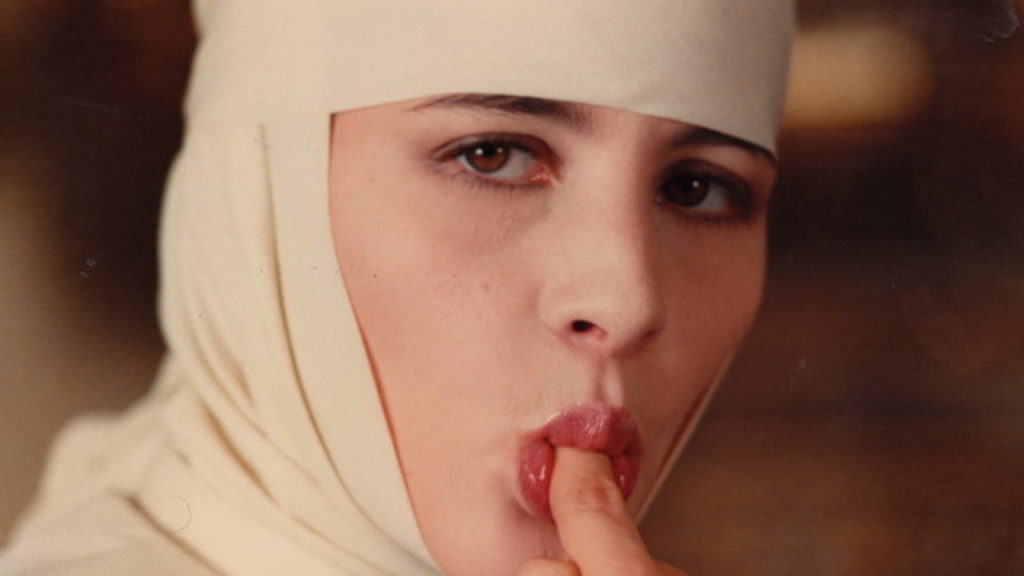
“Just like in war, the knowledge about the other—or ‘intelligence’ about the other—constructs power; it is the currency that economies of love and war operate on. Nevertheless, the collection of knowledge about the other rarely extends beyond pseudo-factual proof of prior suspicion, most frequently deployed to confirm an identity already inscribed onto the other.”
INFRARED DREAMS IN TIMES OF TRANSPARENCY – THE LOVE LIFE OF DRONES AND OTHER WESTERN CYBORGS, Vika Kirchenbauer
Berlin-based artist Vika Kirchenbauer would defiantly say that she is not a filmmaker. Her wide-ranging body of work is, indeed, hard to encapsulate, and is best summarized as a “moving image practice,” which ranges from accomplished cinematic expressions of early 16mm films to minimalist visual performances of the present. What unifies her variety of production and exhibition arrangements of sound and visual creations, however, is that her œuvre emanates an intellectual clarity that overcomes boundaries and tropes fabricated by institutions, artistic disciplines and corporealities.
Kirchenbauer fluidly negotiates notions of masculinity and femininity, closeness, shaming, access, differentiation, and always questions immersion itself. By detaching all these coordinates from accessible, psychological identities, by inventing alternative strategies of mutuality, her work raises questions of personification and embodiment in art as well as within the codes of society. Crucial to this is how Kirchenbauer herself is present in her work: she appears as an opaque artistic persona, a commentator who is often visible, yet always slightly hidden from our gaze. A prototype, she says during one of her video performances, always on the verge of breakdown.
“SEEING DIFFICULTIES”, titled in all capital letters: that’s the first track of Kirchenbauer’s EP MOOD MANAGEMENT (2017), comprised of electronic sounds and manipulated voices. The song, as it were, functions to not merely invoke a psychological mood, but rather point to how moods and mental states are designed. In this abstraction, Kirchenbauer creates a relationship to the world that emphasizes re-arrangement and disconnection from naturalized experience. There is a particular way of “seeing difficulties” going on, in this work as well as in others: a longing to unearth the hidden mechanics of voices and behaviours. Kirchenbauer continues to explore these themes in the video work SHE WHOSE BLOOD IS CLOTTING IN MY UNDERWEAR (2016). Here, two lovers are shot in infrared, their bodies permeated by light. In this work, an intimate touch suddenly becomes a traumatic mark. Soft insides become abstract sketches. The unseen is rendered visible but not necessarily comprehensible.
She appears as an opaque artistic persona, a commentator who is often visible, yet always slightly hidden from our gaze.
Kirchenbauer usually performs both this video and the music in a club setting, accompanied by a video installation that scans the audience in night vision, transforming their bodies as well as their surroundings. Kirchenbauer alienates and re-imagines social arrangements as abstract layouts of forms, of bodies, of thoughts, that were maybe never natural to begin with. The mutualities in her work, the relations established amongst individuals as well as between spectators and experiences of art, are inseparable from a certain abstraction or from the necessity of critical perspectives. As she says: “the assumption that art, by merely ‘being art’, possesses a certain critical quality negates all social, political and economic ramifications within which the field operates.” Her videos appear often in groups and in settings where works of art can mutually comment on each other. And even within the works, there are individuals referring to groups and appearing as groups, individuals and groups that offer invitations to consider these relationships.
YOU ARE BORING! (2015) was produced for the particular situation of a a gallery space where people enter with a certain awareness, an openness to carefully interpret every gesture within the works of art on display as well as within the group of spectators: queer performers inhabit a screen, some of them in drag, and the work is screened in 3D. The performers become accessible to the audience through their exhibition on screen, and yet are still just out of arm’s reach—smarter, sexier, and more sophisticated in ways the audience cannot be through spectatorship alone. They become abstract subjects that present themselves as ready for objectification, ready to become an imperative of pleasure. Or is it not? The film resonates with other images throughout her works: KINGDOM COME: RITUALS (2014, with Martin Sulzer), uses impressions of a crowd demonstration, shot from above, from a camera mounted on the back of a bird. Flesh becomes drone, overwhelming when seen on a big screen.
In Kirchenbauer’s works, intimacy is a distinct hope, but in most cases it won’t offer any shelter. Intimate spheres appear as capitalist designs and complicated battlegrounds, as essentially risky. A vulnerable field, where people might get hurt and reduced, misunderstood and stereotyped. A field of strategies as well, in which people might seek to gain power over each other. Her work leaves limited options for closeness and a rich catalogue of problems. Following this logic, she touches, from time to time, a sense of grumpy pessimism or even fatalism. In fact, Kirchenbauer’s works would at times be devastating without the tender irony they often demonstrate.
In this ironic humour, however, there is a dimension of hope. Hope as a position towards the world that is based on understanding and subversively re-arranging its limitations. Kirchenbauer’s videos carefully negotiate borderlines, as they illustrate potentials of being visible while remaining undiscovered, autonomous and opaque. Referring to Édouard Glissant[i], Kirchenbauer defends a notion of controlled visuality as a way to design one’s self and the perception of this self. It’s this resistance against the visual, against the obvious, against constellations of stereotyped naturality and power within society that defines her work.





